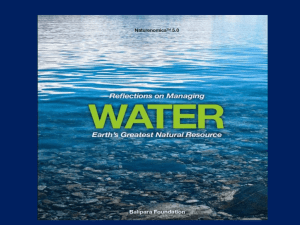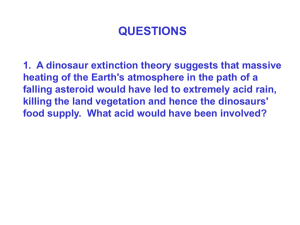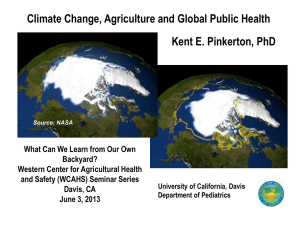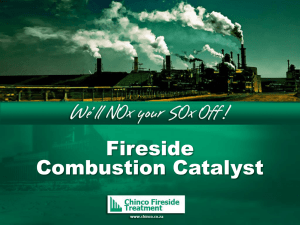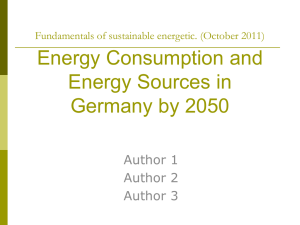Externalities Powerpoint show
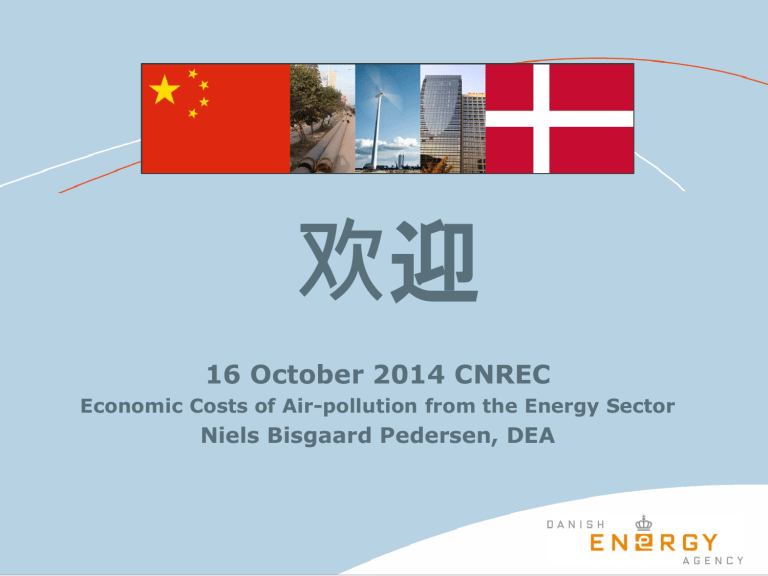
欢 迎
16 October 2014 CNREC
Economic Costs of Air-pollution from the Energy Sector
Niels Bisgaard Pedersen, DEA
PROGRAM
Beijing, The Guardian 14/01/2013
Beijing
3
Source: OECD
4
Externalities
• A cost or benefit that affects a third party who did not chose to incur that cost/benefit
• Noise, air-pollution, water-pollution, accidents, waiting-time in transportation, visual pollution of the landscape, damage on flora and fauna etc.
• Local, trans-border and global impacts
• Irreversible or reversible damage impacts
5
Externalities
• PRIVATE COSTS – observed market costs
• SOCIAL COSTS – includes damage imposed by harmful air-emissions:
• Green-house gasses - Global warming
• SO2 – mortality, morbidity, acid rain, damage agriculture and buildings
• NOx – increased morbidity/mortality
• PM2.5 – increased mortality/morbidity
• Ozone – increased mortality/morbidity
6
Consequence an negative externality
Price is low and consumption to high, a non-efficient allocation of resources
7
Social Costs - Principle
Result:
Produce and consume too much conventional and too little wind energy
China
• A Word Bank reports that China’s
• PM10 health damage represented nearly
700 billion RMB in 2009 or 2.8% of GDP
• CO2 damage represents 1.0 % of GDP
• Material damage from air pollution represents 0.5 % of GDP
• Other studies estimate health related costs to pollution are 6% of GDP in 2005
CNREC - DEA Study
• CNRECs scenario tool CREAM quantifies the direct cost of energy production from the different energy technologies and the emission of harmful gases from combustion of fossil fuels.
• But the more indirect environmental costs are not quantified. This activity will use methodologies from
Europe, meteorological modelling for China and empiric data from China to integrate environmental cost in CREAM.
Focus will be on health effect on human health from emission of SO2, NOx, and CO2.
• CNREC responsible: Xie Xuxuan.
• DEA responsible: Niels Bisgaard Pedersen.
• External Assistance Yanxu Zhang, Harvard University
Impact Pathway Approach
Methodologies
Source – Scenarios
Result
Emissions of CO2, SO2, SO4,
NOx, PM2.5, PM10 etc.
Dispersion in the air.
Travelling distance possibly chemical reactions in the atmosphere (atmospheric dispersion models)
Increase in pollutants concentration at receptor sites
(concentration of substances in the air)
10
Dose-response function, exposure-response or concentration-response function
Monetary evaluation
Impacts on human health in terms of mortality and morbidity
Economic Cost (loss of income, costs for health system)
11
CNREC – DEA Scenarios 2015 - 2050
CO2 emissions in million ton per year
10000
9000
8000
7000
6000
5000
4000
3000
2000
1000
0
REF
Renewable Energy
12
7
6
5
4
3
2
1
0
10
9
8
CNREC – DEA Scenarios 2015 - 2050
SO2 emissions in million ton per year
Reference Scenario
Max Renewable Energy
13
7
6
5
4
3
2
1
0
10
9
8
CNREC – DEA Scenarios 2015 - 2050
NOx emissions in million ton per year
Reference Scenario
Max Renewable Energy
14
7
6
5
4
3
2
1
0
10
9
8
CNREC – DEA Scenarios 2015 - 2050
VOC emissions in million ton per year
Reference Scenario
Max Renewable Energy
Atmospheric Dispersion Model
• An air-quality model for China (GEOS-
Chem)
• Present day meteorological data (2004) and future emission data for 2015, 2020,
2030, 2040 and 2050
• Spatial allocation based on existing inventories for China
16
Predicted difference in concentration of ozone 2050 REF – MAX RE
50 o
N
45 o N
40 o N
35 o N
30 o
N
25 o
N
20 o
N
80 o
E 90 o
E 100 o
E 110 o
E 120 o
E 130 o
E
0.00
1.50
3.00
4.50
6.00
ppbv
Predicted diffence in concentration of
PM2.5 non-dust 2050 - REF – MAX RE
50 o
N
45 o
N
40 o
N
35 o
N
30 o
N
25 o
N
20 o
N
80 o
E 90 o
E 100 o
E 110 o
E 120 o
E 130 o
E
2.50
5.00
7.50
10.00
17
0.00
ug/m3
18
Predicted diffence in concentration of
SO2 2050 REF – MAX RE
19
Predicted diffence in concentration of
NOx 2050 - REF – MAX RE
50 o
N
45 o
N
40 o
N
35 o
N
30 o
N
25 o
N
20 o
N
80 o
E 90 o
E 100 o
E 110 o
E 120 o
E 130 o
E
0.00
1.00
2.00
3.00
4.00
ppbv
20
Pollutants and their impacts
Primary Pollutant Secondary
Pollutant
Particles
SO2
SO4
NOx
NOx
NOx+VOC
CO
Greenhouse Gases
Sulphates
Nitrates
Ozone
Impacts (Endpoints)
Mortality
Cardio-pulmonary morbidity
Mortality
Cardio-pulmonary morbidity
Like particles
Morbidity (? Not verified)
Like particles
Mortality
Morbidity
Mortality
Morbidity
None directly (Global warming)
Impact of harmful air- emissions
• Estimation of human health impacts based on responsiveness to air-quality
• Impact Response function ΔMort= y
0
• y
0 is the baseline mortality rate,
(1-e -βΔC )Pop
• β is the concentration-response factor,
• ΔC is the concentration difference of pollutants between RE and REF scenarios,
• Pop is the exposed population.
• β is derived from relative risks (RR) estimated in long-term epidemiological studies assuming log-linear relationships between pollutant concentrations and RR
Quantification of impact of harmful air- emissions
• Mortality from Ozone and PM2.5
• Ozone a concentration-response factor of 0.52%
(0.27%-0.77% as 95% confidence interval) increase in mortality per 10 ppbv increase of ozone (Bell et al.,
2004)
• PM2.5: Mean of four studies over China: 0.35% per 10
μg/m 3 increase and 2.96% per 10 μg/m 3 increase for long term impacts
• NOx impacts are uncertain and SO2 impacts are relatively small
• Population and mortality data for each province is based on National Bureau of Statistics of China
23
Avoided number of deaths in China by following
Max RE scenario 2015 -2050
100000
90000
80000
70000
60000
50000
40000
30000
20000
10000
0
2015
PM2.5
Ozone
2020
Avoided death are estimated to 1 750
000 for the period
2015 - 2050
2030 2040 2050
Economic valuation of health impact of harmful air- emissions
• Monetisation according damage costs principles:
• Mortality
• Lost income/Willingness To Pay (WTP)/Value of Statistical
Life (VSL)
• VSL willingness to pay for a small reduction in the risk of premature mortality
• Morbidity
• Increased illness, hospitalisation, medication, lost working days (respiratory diseases)
• VSL for China = 1.68 million RMB in 2010 price level
• Economic Value = 2.9 trillion RMB 2015 – 2050 = 83 billion RMB per year in average
25
Economic costs from premature mortality in Million RMB
Difference between REF and MAX RE
180000
160000
140000
120000
100000
80000
60000
40000
20000
0
PM2.5
Ozone
Marginal costs benefits of emission on human health in China - RE scenario
+- 10%
SO2 RMB per ton
4 800
Nox RMB per ton VOC RMB per ton
21 900 2 700
Economic Costs of CO2 emissions
Source Costs of CO2 per ton Comment
ExternE project
Emission Trade
Systems China
Emission Trade
System Europe
Environmental
Protection Agency
25 USD
3.6 – 20 USD
< 1 USD
21 USD
2 700
6 pilot projects
Number of emission permission too high.
Long term forecast 45
USD
Damage cost assessment. Recently updated.
Recommended
Economic Costs of air-pollution
Million RMB
700000
600000
500000
400000
300000
200000
100000
0
28
CO2
VOC
Nox
SO2
29
Future Directions
Uncertainty Solution
More pollutants needs analysed PM10 etc.
Only mortality and damage from CO2 is included
Dose – Response function
Spatial allocation of emission the same in the two scenarios
Present meteorological conditions for the whole period
Morbidity, impact in agriculture and material damage should be included
Long term cohort studies in
China
Calculate emissions at a regional level in CREAM
Feed back between air-pollution and climate change needs to be taken into consideration
Internalisation - Policy
• Taxes and duties on CO2, SO2, Nox to reduce pollution
• CO2 trading schemes
• Revenue to support renewable energy deployment wind, solar and biomass
• High environmental standards for power plants, heavy industry, vehicles and fuels




